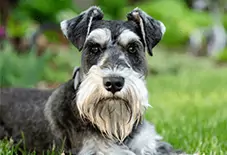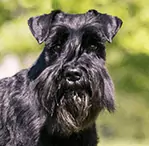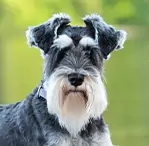
Meet the Schnauzer
High Doggy I.Q.
Best Fur Friend
Pawfect Playmate
My Many Looks
My Breed Characteristics
Furbulous Fact
As I Grow Up
History of My Breed
Care Tips
Training Tips
Personality
Smart
Playful
Affectionate
Group
Working
Origin
Germany
Life Span
13-16 Years
Breed Popularity
#92 of 195
Height Range
17.5-19.5 Inches
Weight Range
30-50 Pounds
Coat Details
Type
Medium
Texture
Wiry
Features
Double Coat
Colors
Black; Salt & Pepper
Hypoallergenic
Yes
Cost to Buy
$900-$2,600
Lifetime Care Cost
$26,585
My Many Looks
My Breed Characteristics
Furbulous Fact
As I Grow Up



History of My Breed
Care Tips
from Dr. Jessica Greenberg, Associate VeterinarianKeep an eye out for bladder stones.
Schnauzers are prone to bladder stones, which are rock-like formations of minerals that develop in the urinary tract and cause great discomfort. Be watchful of changes in house breaking or other urinary issues.
Talk to your vet about possible eye issues.
Schnauzers are prone to a few eye disorders, like cataracts and keratoconjunctivitis (dry eye), so speak to your breeder about any genetic eye problems your Schnauzer could be prone to. Genetic screenings are also available for some heritable eye issues, so speak to your vet regarding those.
Look out for itchy skin.
Schnauzers are prone to atopic dermatitis, so be on the lookout for itchy skin, constant skin infections or ear infections, and speak to your vet about the best method of treatment for your dog.
Training Tips
from Dr. Jessica Greenberg, Associate VeterinarianDon’t teach your Schnauzer to jump on people.
Schnauzers are excitable dogs that tend to jump on people. Teach your Schnauzer puppy to sit when they greet people. If they do jump, don’t pet or talk to them. Simply turn your back to them and wait until they sit down again to acknowledge them. You can always train your dog to jump on command by doing a chest tapping motion. That way, you’re in control and it teaches your pup good social etiquette.
Discourage your Schnauzer from jumping on other dogs.
When Schnauzers meet new dogs, they want to jump on them. Other dogs, especially bigger ones, will see this as a challenge. Teach your Schnauzer to sit when greeting a new dog, just like you would teach it to greet humans. This also makes your Schnauzer trust you more because you’re controlling the flow of the interaction, which leads to better encounters with new dog friends. Early socialization is important for this breed.
If your Schnauzer is a barker, ignore them.
Don’t respond to your Schnauzer when they’re barking, no matter how hard it may be. When your dog starts barking, you need to be emotionally blank about it. Go to a zen place, ignore the bark, and calmly leave the room. Schnauzers tend to bark when people enter their home, so consider putting them on a leash and giving them a spot to go to when people arrive. Let your dog know that they can get what they want when they’re quiet, and they get nothing when they’re barking.
My Many Looks
My Breed Characteristics
Furbulous Fact
As I Grow Up
History of My Breed
Care Tips
Training Tips
-
Personality
Smart
Playful
Affectionate
-
Group
Working
-
Origin
Germany
-
Life Span
13-16 Years
-
Breed Popularity
#92 of 195
-
Height Range
17.5-19.5 Inches
-
Weight Range
30-50 Pounds
-
动物皮毛
Type
Medium
Texture
Wiry
Features
Double Coat
Colors
Black; Salt & Pepper
-
Hypoallergenic
Yes
-
Cost to Buy
$900-$2,600
-
Lifetime Care Cost
$26,585

